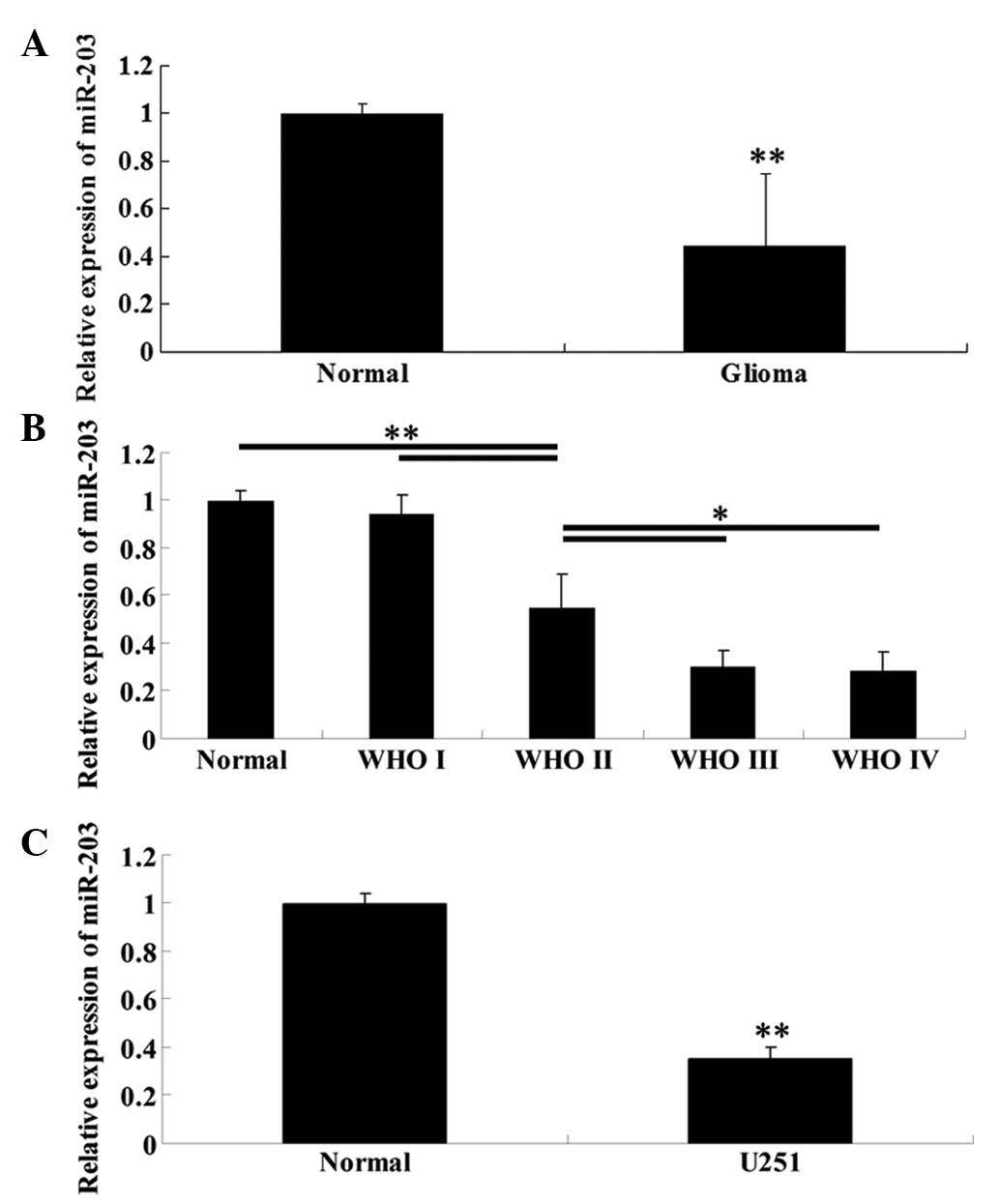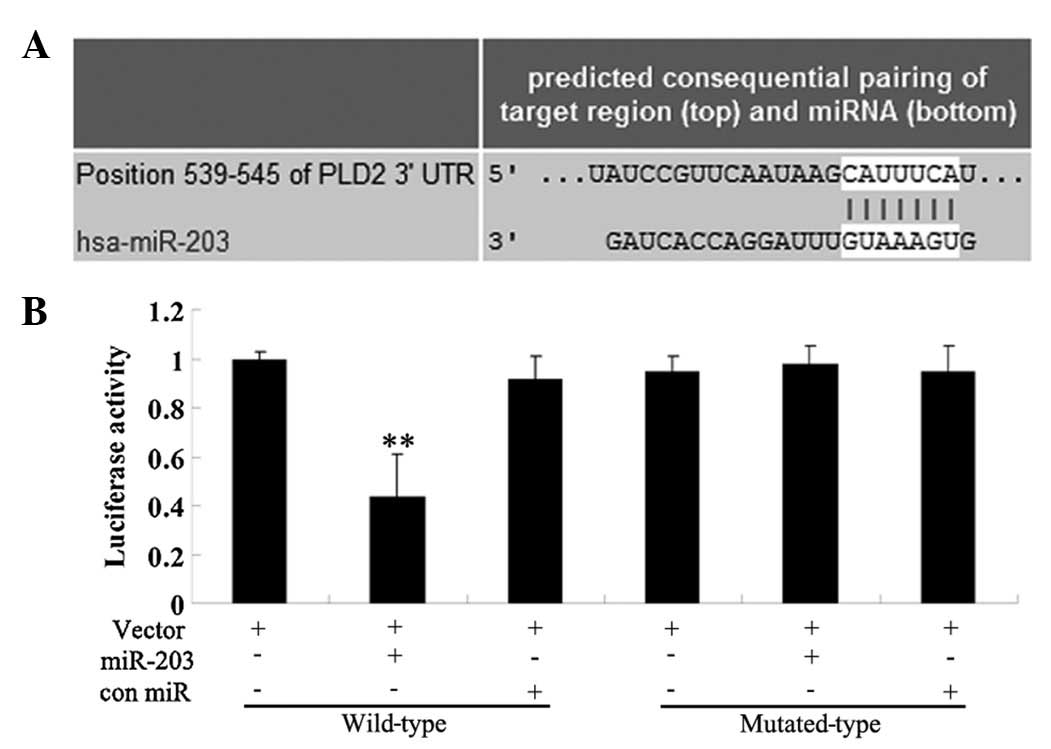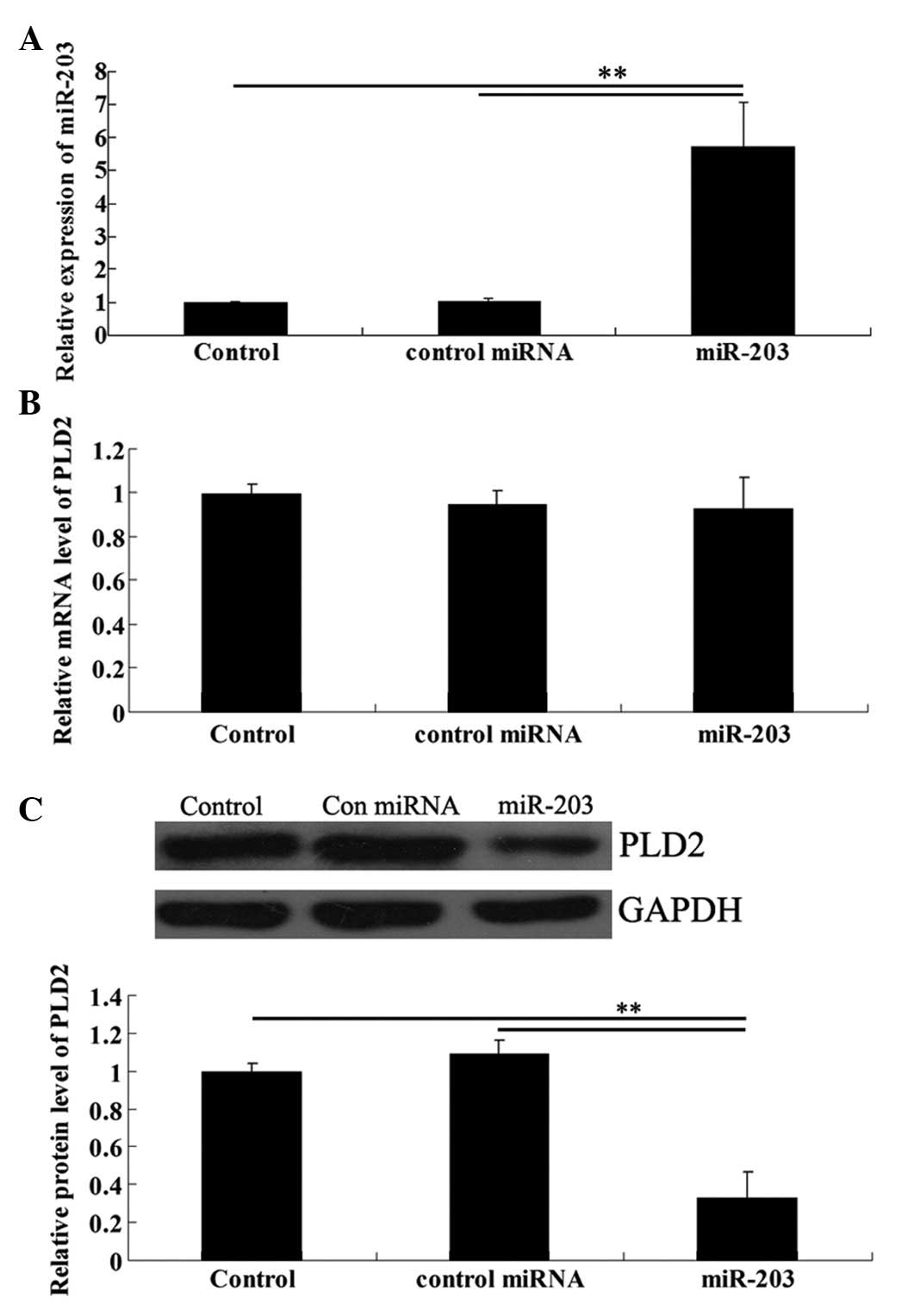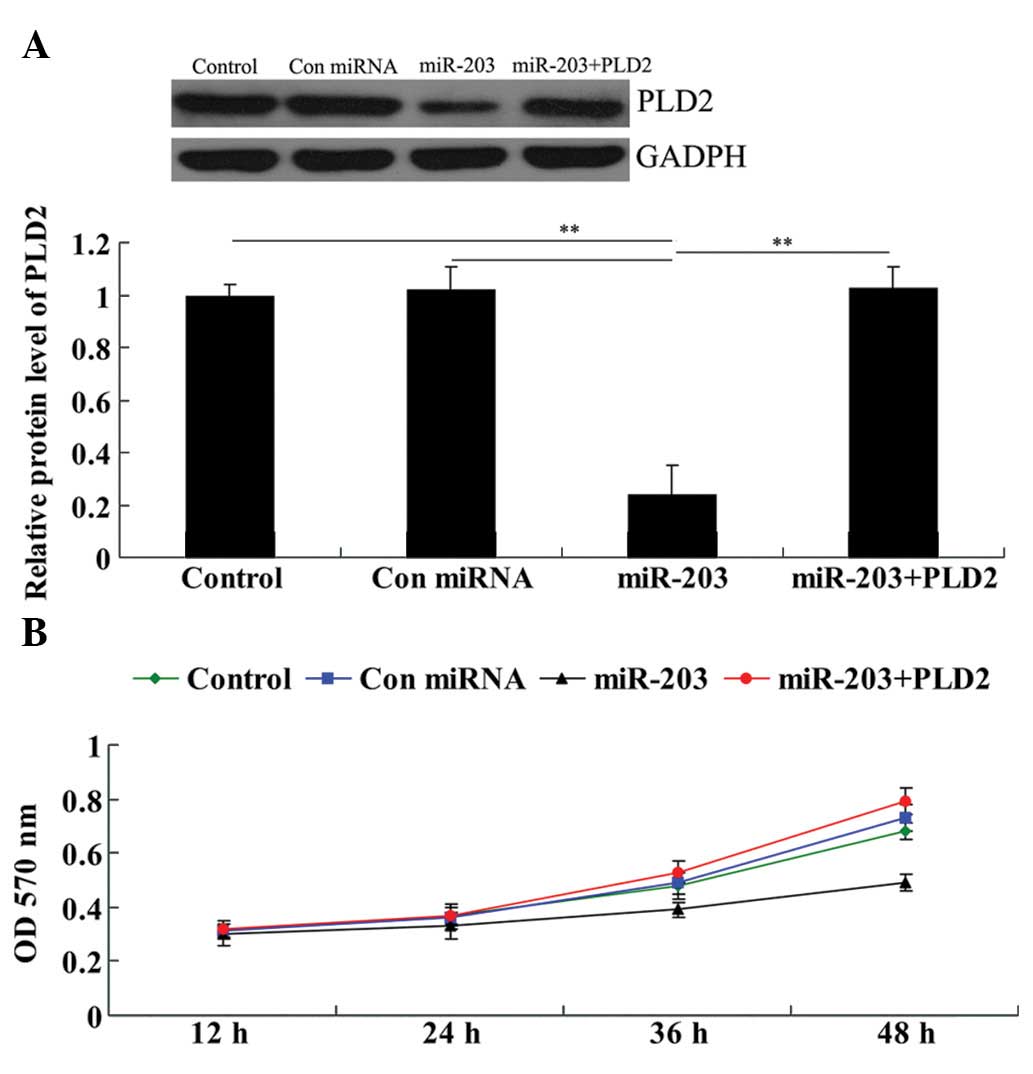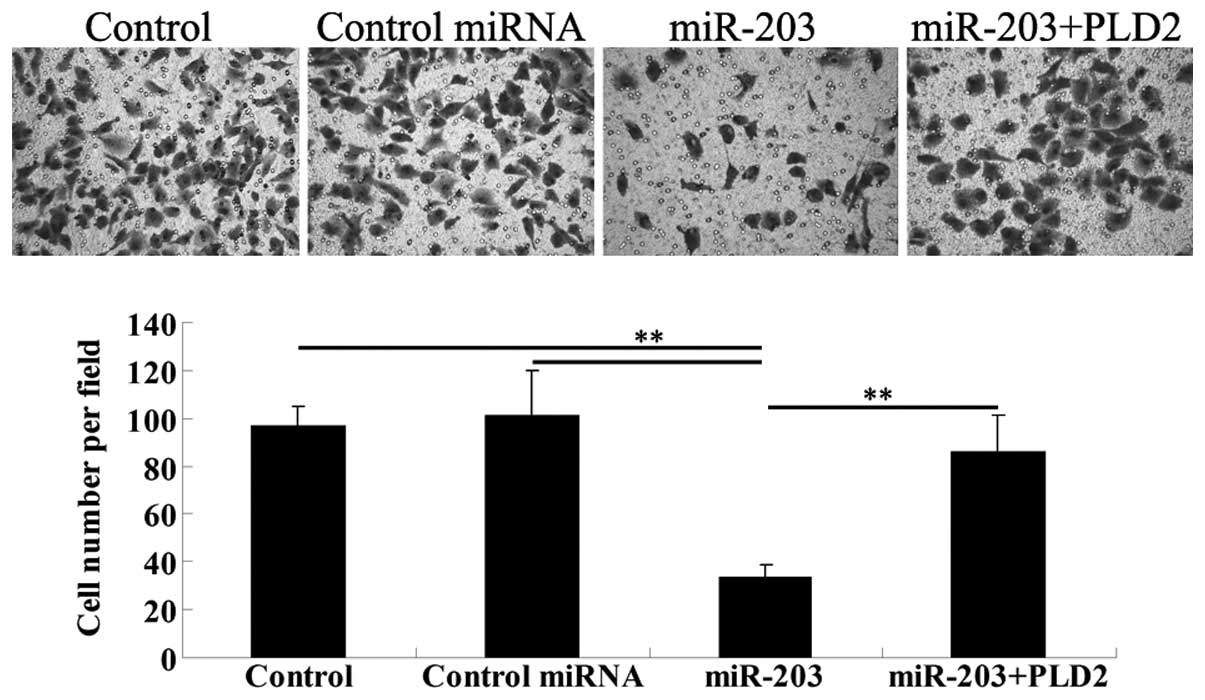MicroRNA-203 inhibits the proliferation and invasion of U251 glioblastoma cells by directly targeting PLD2
Retraction in: /10.3892/mmr.2023.13154
- Authors:
- Published online on: November 20, 2013 https://doi.org/10.3892/mmr.2013.1814
- Pages: 503-508
Abstract
Introduction
Gliomas are among the most common brain malignant tumors and account for ~80% of cancers in the central nervous system. Over previous decades, the 5-year survival rate of high WHO grade gliomas, including glioblastoma, was only 2% with a median survival rate of 1 year (1,2). Furthermore, since malignant glioma is resistant to radiotherapy, chemotherapy and adjuvant therapies, its prognosis has not improved for a long time (3). Thus, the development of effective therapeutic strategies for the treatment of glioblastoma are required.
MicroRNAs (miRNAs), endogenous non-coding small RNAs of 19–25 nucleotides in length, regulate gene expression through binding to the 3′ untranslated region (UTR) of target mRNAs, which eventually results in either mRNA degradation or translational repression. Thus, miRNAs are important in endogenous RNA interference (4). It is well established that miRNAs have comprehensive biological functions and are involved in various processes, including cell survival, proliferation, differentiation, apoptosis and migration (5). Previously, accumulating evidence has revealed that miRNAs are crucial in brain physiology and tumorigenesis (6), making them promising candidates for the therapy of malignant gliomas. In addition, over half of the miRNAs are located in cancer-related genomic regions and the deregulation of certain miRNAs have been found to be closely associated with the development and progression of certain types of cancer, by increasing the expression of certain oncogenes or downregulating the expression of certain tumor suppressors (7,8).
The aberrant expression of microRNA-203 (miR-203) has been found to be decreased in various types of cancer, including melanoma, colon cancer, prostate cancer, hepatocellular carcinoma, esophageal squamous cell carcinoma, glioma and laryngeal cancer (9–14). Furthermore, miR-203 has been suggested to act as a tumor-suppressive microRNA in several types of cancer by directly targeting certain oncogenes (15–17). However, the detailed role of miR-203 in glioblastoma has never been studied.
In the present study, we revealed that the high WHO grade glioma tissues demonstrated a notably decreased miR-203 level compared with low WHO grade glioma tissues as well as normal brain tissues, and a decreasing tendency with increasing WHO grades. Furthermore, the ectopic overexpression of miR-203 inhibited the cell proliferation and invasion of U251 glioblastoma cells, partially at least through inhibiting the protein expression of its target, phospholipase D2 (PLD2).
Materials and methods
Reagents and materials
Fetal bovine serum (FBS), TRIzol, TaqMan Reverse Transcription kit, TaqMan miRNA assay kit, Power SYBR-Green kit, Lipofectamine 2000, miR-203 mimic and enhanced chemiluminescence reagent were purchased from Thermo Fisher Scientific (Waltham, MA, USA). Dulbecco’s modified Eagle’s medium (DMEM) was purchased from Gibco-BRL (Grand Island, NY, USA). The QuikChange site-directed mutagenesis kit was purchased from Stratagene (La Jolla, CA, USA). MTT was obtained from Sigma (St. Louis, MO, USA). The pmirGLO Dual-Luciferase miRNA target expression vector and the Dual-Luciferase assay kit were purchased from Promega (Madison, WI, USA). Mouse anti-PLD2 monoclonal antibody, mouse anti-GAPDH monoclonal antibody and rabbit anti-mouse secondary antibody were purchased from Abcam (Cambridge, UK). The transwell chamber was obtained from Corning Inc. (Corning, NY, USA). Matrigel was obtained from BD Biosciences (Franklin Lakes, NJ, USA). The PcDNA3.1(+)-PLD2 plasmid was purchased from SuperBio (Changsha, Hunan, China).
Tissue specimen collection
All protocols in the present study were approved by the Ethics Committee of Central South University (Changsha, Hunan, China) and informed consent was obtained from each patient involved. Thirty-one glioma tissues of different grades (6 cases of WHO I, 7 cases of WHO II, 9 cases of WHO III and 9 cases of WHO IV) and 10 normal brain tissues were collected from the Department of Neurosurgery of The First Xiangya Hospital of Central South University (Changsha, Hunan, China). Patients with no history of other tumors were diagnosed as having malignant gliomas and were untreated. Following surgical removal, all tissues were immediately frozen in liquid nitrogen and stored at −80°C until use.
Cell culture
The human glioblastoma cell line U251 was purchased from ATCC (Manassas, VA, USA). U251 cells were cultured at 37°C in 5% CO2 in DMEM containing 10% FBS, 100 U/ml of penicillin and 100 μg/ml of streptomycin.
Real-time reverse transcription polymerase chain reaction (RT-PCR) assay
TRIzol reagent was used to extract total RNA, which was then reverse transcribed into cDNA using a TaqMan Reverse Transcription kit. A TaqMan miRNA assay kit was used to examine the expression of mature miR-203 according to the manufacturer’s instructions. U6 small nuclear RNA was used as an internal control. The mRNA expression level of PLD2 was determined by a Power SYBR-Green kit. GAPDH was used as an internal control. The experiments were performed in triplicate. For miRNA all primer sequences were as follows: stem-loop RT primer for miR-203: 5′-GTCG TATCCAGTGCAGGGTCCGAGGTATTCGCACTGGATAC GACCTAGTG-3′; miR-203, forward 5′-GTGCAGGGTCC GAGGT-3′ and reverse 5′-GCCGCGTGAAATGTTTAGG-3′; U6, forward 5′-CTCGCTTCGGCAGCACA-3′ and reverse 5′-AACGCTTCACGAATTTGCGT-3′. For the mRNA assay, primer sequences used were: PLD2, forward 5′-ACTCACG GCGACTTTTCCTG-3′ and reverse 5′-AACGGCAAATC GAGCCAGAG-3′; GAPDH, forward 5′-GGAGCGAGA TCCCTCCAAAAT-3′ and reverse 5′-GGCTGTTG TCATACTTCTCATGG-3′.
Transfection
U251 cells (1×105) were harvested, resuspended and seeded in a 6-well plate and cultured at 37°C in 5% CO2 for 24 h. Lipofectamine 2000 was used to transfect U251 cells with the miR-203 mimic, a control miRNA mimic or the pcDNA3.1(+)-PLD2 plasmid at a final concentration of 200 nM, according to the manufacturer’s instructions.
Western blot analysis
Tissues or cells were solubilized in cold RIPA lysis buffer. Proteins (20 μg per lane) were separated with 12% SDS-PAGE and transferred onto the nitrocellulose membranes, which were then inhibited in 5% non-fat dried milk in phosphate-buffered saline with Tween-20 (PBST) for 3 h. Following that, the membranes were incubated at 4°C overnight with mouse anti-PLD2 monoclonal antibodies (1:500) or mouse anti-GAPDH monoclonal antibodies (1:500). After being washed with PBST for 5 min twice, the membranes were incubated with rabbit anti-mouse secondary antibodies (1:20,000) for 1 h at room temperature. Enhanced chemiluminescence reagent was used to detect the signals on the membranes (Media Cybernetics, Rockville, MD, USA). Image-Pro plus software 6.0 was then applied to scan for the relative value of protein expression, which was presented as the density ratio versus GAPDH.
Luciferase reporter assay
To determine whether or not PLD2 was the direct target of miR-203, a luciferase reporter assay was performed. The 3′-UTR of PLD2 with a potential target sequence of miR-203 was cloned into the pmirGLO Dual-Luciferase miRNA target expression vector. The mutant 3′-UTRs of PLD2 were constructed using a site-directed mutagenesis kit, bearing a substitution of three nucleotides (TTT to CCC) in the miR-203 target sequence. The luciferase reporter plasmids containing wild-type 3′-UTRs or mutant 3′-UTRs of PLD2 were cotransfected with the miR-203 or control miRNA mimic into U251 cells using Lipofectamine 2000 according to the manufacturer’s instructions. Following transfection for 72 h, the luciferase activity in each group was measured using the Dual-Luciferase Assay kit, in accordance with the manufacturer’s instructions. The experiments were performed in triplicate.
Cell proliferation assay
U251 cells (1×105) were plated in a 96-well plate and incubated at 37°C in 5% CO2 for 12, 24, 36 or 48 h. An MTT assay was performed to examine cell proliferation rate. MTT (50 μl; 5 mg/ml) was added and then incubated at 37°C in 5% CO2 for 4 h. The supernatant was removed and 200 μl of dimethyl sulfoxide was added. The absorbance was detected at 570 nm with a microplate reader (Bio-Rad, Hercules, CA, USA). Each assay was performed in triplicate wells and repeated three times.
Cell invasion assay
U251 cells were washed in cold PBS and harvested and resuspended in serum-free DMEM medium. For the invasion assay, 50,000 cells were added into the upper chamber which was pre-coated with Matrigel. Serum-free DMEM medium was added to the upper chamber, while DMEM was added to the lower chamber containing 10% FBS as the chemoattractant. Following 6 h of incubation at 37°C in 5% CO2, cells were fixed with 3.7% formaldehyde and then stained with crystal violet staining solution. A cotton swab was used to remove the cells that did not filter through the membrane. Five fields of the lower surface of the membrane were randomly selected under the microscope and the cells on it were counted.
Statistical analysis
SPSS 17.0 software (SPSS Inc., Chicago, IL, USA) was used for data analysis. Data are presented as the mean ± standard deviation. Statistical analysis was performed using one-way ANOVA or the Student’s t-test. P<0.05 was considered to indicate a statistically significant difference.
Results
Expression of miR-203 is significantly reduced in high WHO grade glioma tissues and glioblastoma U251 cells
To determine the expression levels of miR-203 in glioma tissues of different WHO grades, normal brain tissues, as well as glioblastoma U251 cells, qRT-PCR was performed. As demonstrated in Fig. 1A, the expression of miR-203 in glioma tissues was significantly lower than that in normal brain tissues. Furthermore, with increasing WHO grades, the miR-203 expression was gradually downregulated (Fig. 1B), indicating that its expression was negatively correlated with the malignancy of glioma. Furthermore, consistent with the data above, U251 cells also demonstrated a significantly decreased expression level of miR-203 than normal brain tissues (Fig. 1C).
Identification of PLD2 as a direct target of miR-203
A bioinformatical analysis was performed to predict the potential targets of miR-203 and the results from all nine prediction softwares predicted that PLD2 was its target, including DIANAmT, miRanda, miRDB, miRWalk, RNAhybrid, PICTAR5, PITA, RNA22 and Targetscan (Fig. 2A). To confirm the predictive results, we performed a luciferase reporter assay. The results demonstrated that the luciferase activity was significantly lower in miR-203 and the wild type 3′-UTR of PLD2 cotransfected cells, when compared with that in control cells without transfection with miR-203. However, the luciferase activity in cells cotransfected with miR-203 and the mutated 3′-UTR of PLD2 demonstrated no difference with the control cells (Fig. 2B). These findings demonstrated that the 3′-UTR of PLD2 was the direct target of miR-203.
Expression levels of PLD2 are increased in high WHO grade glioma tissues and U251 cells
The protein expression levels of PLD2 in glioma tissues of different WHO grades and normal brain tissues were examined. As demonstrated in Fig. 3A, the PLD2 protein expression in glioma tissues of high WHO grades was significantly higher than that in normal brain tissues and low WHO grade glioma tissues. Notably, with ascending WHO grades, the PLD2 protein expression demonstrated an increasing tendency. Furthermore, its protein level was also notably higher in U251 cells compared with that in normal brain tissues (Fig. 3B).
miR-203 overexpression downregulates the protein level although not the mRNA level of PLD2 in U251 cells
We transfected U251 cells with the miR-203 mimic. Real-time RT-PCR data confirmed that the expression level of miR-203 was significantly upregulated following transfection (Fig. 4A). To further investigate the effects of miR-203 upregulation on the protein expression of PLD2 in U251 cells, real-time RT-PCR and western blot analysis were performed, respectively. As shown in Fig. 4B, although the mRNA level of PLD2 demonstrated no difference, the PLD2 protein level was significantly reduced following transfection of U251 cells with miR-203 (Fig. 4B).
Overexpression of PLD2 significantly attenuates the inhibitory effect of miR-203 on U251 cell proliferation
Prior to investigating the roles of miR-203 and PLD2 in gliomas in vitro, we contransfected U251 cells with miR-203 mimics and the PLD2 plasmid and determined whether PLD2 transfection could rescue the suppressive effect of miR-203 on PLD2 protein expression. As shown in Fig. 5A, the protein level of PLD2 in the miR-203 + PLD2 group was much higher than that in the miR-203 group and demonstrated no difference with the control group. These results confirmed that PLD2 transfection rescued the suppressive effect of miR-203 on PLD2 protein expression in U251 cells.
We performed a cell proliferation assay to examine the effects of miR-203 and PLD2 on U251 cell proliferation. As demonstrated in Fig. 5B, in miR-203-overexpressed U251 cells, the cell proliferation rate was markedly downregulated. However, the miR-203 + PLD2 group demonstrated no difference with the control group as well as the control miRNA group, indicating that the overexpression of PLD2 abrogated the inhibitory effect of miR-203 on U251 cell proliferation.
Overexpression of PLD2 significantly attenuates the inhibitory effect of miR-203 on U251 cell invasion
To verify our hypothesis that miR-203 inhibits the invasion of U251 cells through a PLD2-dependent mechanism, a cell invasion assay was performed. The results demonstrated that miR-203 significantly downregulated the cell invasion of U251 cells. However, the overexpression of PLD2 rescued the invasion capacity of U251 cells transfected with the miR-203 mimic (Fig. 6).
Discussion
In the present study, we revealed that high WHO grade glioma tissues demonstrated a notably decreased miR-203 level compared with low WHO grade glioma tissues and normal brain tissues, as well as a decreasing tendency with increasing WHO grades. We also demonstrated that ectopic overexpression of PLD2 inhibited the cell proliferation and invasion of glioblastoma U251 cells, at least by suppressing the PLD2 protein expression.
It is well established that the aberrant expression of multiple miRNAs is associated with the development and progression of gliomas, including miR-145, miR-383 and miR-34a (18–20). Previously, He et al reported that the expression of miR-203 was downregulated in gliomas compared with normal brain tissues and decreased with increasing tumor WHO grades (14), which was consistent with our data. Furthermore, the authors also demonstrated that miR-203 was a potential prognostic indicator for the survival rate of patients with glioma (14). Accordingly, those as well as our findings suggest that miR-203 is important in gliomas. However, no previous study has revealed the exact role of miR-203 in high WHO grade glioma cells. Thus, we performed the transfection of glioblastoma U251 cells with the miR-203 mimic and demonstrated for the first time, to the best of our knowledge, that miR-203 overexpression inhibited U251 cell proliferation and invasion. These data confirm the regulatory role of miR-203 in glioblastoma cells.
Thus far, several targets of miR-203 have been identified, including interleukin-8, Hakai, LASP1 and Survivin (17,21–23). However, no target of miR-203 has been identified in gliomas. The present study suggests that the effect of miR-203 on U251 cells is possibly via suppressing the expression of its novel identified target, PLD2. This gene could encode a protein which catalyzes the hydrolysis of phosphatidylcholine to phosphatidic acid and choline and may participate in transcriptional regulation, cell cycle control and regulated secretion (24). Furthermore, it is crucial in cell membrane lipid reorganization and acts as a key cell signaling protein in leukocyte chemotaxis and phagocytosis (25).
PLD2 has been suggested to be important in several cancer cells, including renal cancer, breast cancer, lung adenocarcinoma, colorectal carcinoma, ovarian cancer and glioma (26–31). For instance, a previous study reported that the PLD2 selective inhibitor ML298 inhibited U87-MG glioblastoma cell invasion (31). In the present study, we demonstrated that the overexpression of PLD2 abrogated the inhibitory effects of PLD2 on cell proliferation and invasion in glioblastoma U251 cells. According to these findings and ours, we suggest that PLD2 may be oncogenic in glioblastoma. Furthermore, the exact regulatory mechanisms by which PLD2 is involved in the development and progression of several types of cancer have gradually been identified. For instance, Choi et al demonstrated that PLD2 upregulation enhanced the activity of ERK and p38 MAPK signaling pathways and further activated STAT3, eventually increasing the expression of anti-apoptotic Bcl-2 in human cervical cancer HeLa cells (32). In addition, COX-2 is involved in the growth and progression of gliomas and PLD2 was reported to enhance CoCl(2)-induced COX-2 expression via reactive oxygen species and p38 MAPK in astroglioma cells (33). Further studies need to focus on the molecular mechanisms underlying the role of PLD2 in gliomas.
In conclusion, the present study for the first time, to the best of our knowledge, has demonstrated an inhibitory role of miR-203 in glioblastoma U251 cells via targeting PLD2 and suggests that miR-203 is a potential candidate for the treatment of glioblastoma.
References
|
Surawicz TS, Davis F, Freels S, Laws ER Jr and Menck HR: Brain tumor survival: results from the National Cancer Data Base. J Neurooncol. 40:151–160. 1998. View Article : Google Scholar : PubMed/NCBI | |
|
Bondy ML, Scheurer ME, Malmer B, et al: Brain tumor epidemiology: consensus from the Brain Tumor Epidemiology Consortium. Cancer. 113:1953–1968. 2008. View Article : Google Scholar : PubMed/NCBI | |
|
Chargari C, Moncharmont C, Lévy A, et al: Cancer stem cells, cornerstone of radioresistance and perspectives for radiosensitization: glioblastoma as an example. Bull Cancer. 99:1153–1160. 2012.(In French). | |
|
Schepeler T: Emerging roles of microRNAs in the Wnt signaling network. Crit Rev Oncog. 18:357–371. 2013. View Article : Google Scholar : PubMed/NCBI | |
|
Yates LA, Norbury CJ and Gilbert RJ: The long and short of microRNA. Cell. 153:516–519. 2013. View Article : Google Scholar : PubMed/NCBI | |
|
Nikaki A, Piperi C and Papavassiliou AG: Role of microRNAs in gliomagenesis: targeting miRNAs in glioblastoma multiforme therapy. Expert Opin Investig Drugs. 21:1475–1488. 2012. View Article : Google Scholar : PubMed/NCBI | |
|
Profumo V and Gandellini P: MicroRNAs: cobblestones on the road to cancer metastasis. Crit Rev Oncog. 18:341–355. 2013. View Article : Google Scholar : PubMed/NCBI | |
|
Farazi TA, Hoell JI, Morozov P and Tuschl T: MicroRNAs in human cancer. Adv Exp Med Biol. 774:1–20. 2013. View Article : Google Scholar | |
|
Noguchi S, Mori T, Otsuka Y, et al: Anti-oncogenic microRNA-203 induces senescence by targeting E2F3 protein in human melanoma cells. J Biol Chem. 287:11769–11777. 2012. View Article : Google Scholar : PubMed/NCBI | |
|
Furuta M, Kozaki KI, Tanaka S, Arii S, Imoto I and Inazawa J: miR-124 and miR-203 are epigenetically silenced tumor-suppressive microRNAs in hepatocellular carcinoma. Carcinogenesis. 31:766–776. 2010. View Article : Google Scholar : PubMed/NCBI | |
|
Schetter AJ, Leung SY, Sohn JJ, et al: MicroRNA expression profiles associated with prognosis and therapeutic outcome in colon adenocarcinoma. JAMA. 299:425–436. 2008. View Article : Google Scholar : PubMed/NCBI | |
|
Boll K, Reiche K, Kasack K, et al: MiR-130a, miR-203 and miR-205 jointly repress key oncogenic pathways and are downregulated in prostate carcinoma. Oncogene. 32:277–285. 2013. View Article : Google Scholar : PubMed/NCBI | |
|
Yuan Y, Zeng ZY, Liu XH, et al: MicroRNA-203 inhibits cell proliferation by repressing DeltaNp63 expression in human esophageal squamous cell carcinoma. BMC Cancer. 11:572011. View Article : Google Scholar : PubMed/NCBI | |
|
He J, Deng Y, Yang G and Xie W: MicroRNA-203 down-regulation is associated with unfavorable prognosis in human glioma. J Surg Oncol. 108:121–125. 2013. View Article : Google Scholar : PubMed/NCBI | |
|
Bian K, Fan J, Zhang X, et al: MicroRNA-203 leads to G1 phase cell cycle arrest in laryngeal carcinoma cells by directly targeting survivin. FEBS Lett. 586:804–809. 2012. View Article : Google Scholar : PubMed/NCBI | |
|
Wang C, Zheng X, Shen C and Shi Y: MicroRNA-203 suppresses cell proliferation and migration by targeting BIRC5 and LASP1 in human triple-negative breast cancer cells. J Exp Clin Cancer Res. 31:582012. View Article : Google Scholar : PubMed/NCBI | |
|
Wei W, Wanjun L, Hui S, Dongyue C, Xinjun Y and Jisheng Z: miR-203 inhibits proliferation of HCC cells by targeting survivin. Cell Biochem Funct. 31:82–85. 2013. View Article : Google Scholar : PubMed/NCBI | |
|
Rani SB, Rathod SS, Karthik S, Kaur N, Muzumdar D and Shiras AS: MiR-145 functions as a tumor-suppressive RNA by targeting Sox9 and adducin 3 in human glioma cells. Neuro Oncol. 15:1302–1316. 2013. View Article : Google Scholar : PubMed/NCBI | |
|
He Z, Cen D, Luo X, et al: Downregulation of miR-383 promotes glioma cell invasion by targeting insulin-like growth factor 1 receptor. Med Oncol. 30:5572013. View Article : Google Scholar : PubMed/NCBI | |
|
Gao H, Zhao H and Xiang W: Expression level of human miR-34a correlates with glioma grade and prognosis. J Neurooncol. 113:221–228. 2013. View Article : Google Scholar : PubMed/NCBI | |
|
Wei T, Xu N, Meisgen F, Ståhle M, Sonkoly E and Pivarcsi A: Interleukin-8 is regulated by miR-203 at the posttranscriptional level in primary human keratinocytes. Eur J Dermatol. Apr 19–2013.(Epub ahead of print). | |
|
Abella V, Valladares M, Rodriguez T, et al: miR-203 regulates cell proliferation through its influence on Hakai expression. PLoS One. 7:e525682012. View Article : Google Scholar : PubMed/NCBI | |
|
Takeshita N, Mori M, Kano M, et al: miR-203 inhibits the migration and invasion of esophageal squamous cell carcinoma by regulating LASP1. Int J Oncol. 41:1653–1661. 2012.PubMed/NCBI | |
|
Szumiło M and Rahden-Staroń I: Phospholipase D in mammalian cells: structure, properties, physiological and pathological role. Postepy Hig Med Dosw (Online). 60:421–430. 2006.(In Polish). | |
|
Gomez-Cambronero J: Biochemical and cellular implications of a dual lipase-GEF function of phospholipase D2 (PLD2). J Leukoc Biol. 92:461–467. 2012. View Article : Google Scholar : PubMed/NCBI | |
|
Zhao Y, Ehara H, Akao Y, et al: Increased activity and intranuclear expression of phospholipase D2 in human renal cancer. Biochem Biophys Res Commun. 278:140–143. 2000. View Article : Google Scholar : PubMed/NCBI | |
|
Eisen SF and Brown HA: Selective estrogen receptor (ER) modulators differentially regulate phospholipase D catalytic activity in ER-negative breast cancer cells. Mol Pharmacol. 62:911–920. 2002. View Article : Google Scholar | |
|
Meacci E, Nuti F, Catarzi S, et al: Activation of phospholipase D by bradykinin and sphingosine 1-phosphate in A549 human lung adenocarcinoma cells via different GTP-binding proteins and protein kinase C delta signaling pathways. Biochemistry. 42:284–292. 2003. View Article : Google Scholar : PubMed/NCBI | |
|
Saito M, Iwadate M, Higashimoto M, Ono K, Takebayashi Y and Takenoshita S: Expression of phospholipase D2 in human colorectal carcinoma. Oncol Rep. 18:1329–1334. 2007.PubMed/NCBI | |
|
Snider AJ, Zhang Z, Xie Y and Meier KE: Epidermal growth factor increases lysophosphatidic acid production in human ovarian cancer cells: roles for phospholipase D2 and receptor transactivation. Am J Physiol Cell Physiol. 298:C163–C170. 2010. View Article : Google Scholar | |
|
O’Reilly MC, Scott SA, Brown KA, et al: Development of dual PLD1/2 and PLD2 selective inhibitors from a common 1,3,8-Triazaspiro[4.5]decane Core: discovery of Ml298 and Ml299 that decrease invasive migration in U87-MG glioblastoma cells. J Med Chem. 56:2695–2699. 2013.PubMed/NCBI | |
|
Choi HJ and Han JS: Overexpression of phospholipase D enhances Bcl-2 expression by activating STAT3 through independent activation of ERK and p38MAPK in HeLa cells. Biochim Biophys Acta. 1823:1082–1091. 2012. View Article : Google Scholar : PubMed/NCBI | |
|
Ahn BH, Park MH, Lee YH, Kwon TK and Min do S: Up-regulation of cyclooxygenase-2 by cobalt chloride-induced hypoxia is mediated by phospholipase D isozymes in human astroglioma cells. Biochim Biophys Acta. 1773:1721–1731. 2007. View Article : Google Scholar : PubMed/NCBI |



